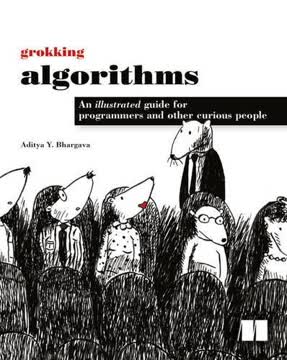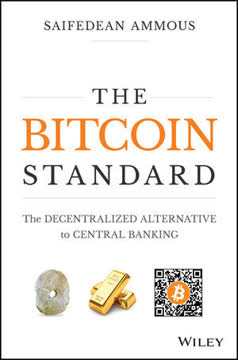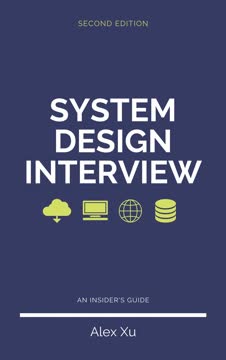Key Takeaways
1. Blockchain: A revolutionary distributed ledger technology
Blockchain at its core is a peer-to-peer distributed ledger that is cryptographically secure, append-only, immutable (extremely hard to change), and updateable only via consensus or agreement among peers.
Distributed architecture. Blockchain technology operates on a network of computers, each maintaining a copy of the ledger. This decentralized approach eliminates the need for a central authority, enhancing security and transparency.
Immutability and consensus. Once data is recorded on the blockchain, it becomes extremely difficult to alter. This immutability is ensured through cryptographic techniques and the consensus mechanism, where network participants must agree on the validity of new transactions before they are added to the ledger.
Key features of blockchain:
- Decentralization
- Transparency
- Security
- Immutability
- Consensus-driven updates
2. Bitcoin: The first and most prominent blockchain application
Bitcoin was released in 2009 and the first alternative coin project (named Namecoin) was introduced in 2011.
Pioneering cryptocurrency. Bitcoin, introduced by the pseudonymous Satoshi Nakamoto, was the first successful implementation of blockchain technology. It solved the double-spending problem in digital currencies without requiring a trusted third party.
Proof of Work consensus. Bitcoin uses a Proof of Work (PoW) mechanism to validate transactions and create new blocks. Miners compete to solve complex mathematical puzzles, with the winner earning the right to add the next block to the chain and receive newly minted bitcoins as a reward.
Bitcoin's key components:
- Decentralized network of nodes
- Public and private key cryptography
- Blockchain as a public ledger
- Mining process for transaction validation
- Limited supply of 21 million coins
3. Ethereum: Programmable blockchain with smart contracts
Ethereum was conceptualized by Vitalik Buterin in November 2013. The key idea proposed was the development of a Turing-complete language that allows the development of arbitrary programs (smart contracts) for blockchain and decentralized applications.
Smart contract platform. Ethereum extends blockchain technology beyond simple value transfer, enabling the creation and execution of complex, programmable agreements called smart contracts. These contracts can automate various processes and interactions without intermediaries.
Ethereum Virtual Machine (EVM). The EVM is a decentralized computer that executes smart contracts. It allows developers to create decentralized applications (DApps) using languages like Solidity, which are then compiled into EVM bytecode for execution on the network.
Ethereum ecosystem components:
- Ether (ETH) as native cryptocurrency
- Gas for transaction and computation fees
- Decentralized applications (DApps)
- Ethereum Improvement Proposals (EIPs) for protocol upgrades
4. Alternative coins: Diverse cryptocurrencies beyond Bitcoin
Since the initial success of bitcoin, many alternative currency projects have been launched.
Diverse cryptocurrency landscape. Altcoins, or alternative cryptocurrencies, have emerged to address perceived limitations of Bitcoin or to serve specific use cases. These coins often introduce innovative features or consensus mechanisms.
Technological innovations. Many altcoins have introduced novel concepts such as improved privacy (e.g., Monero, Zcash), faster transaction times (e.g., Litecoin), or different consensus mechanisms (e.g., Proof of Stake in Cardano).
Notable altcoin categories:
- Privacy coins
- Stablecoins
- Utility tokens
- Governance tokens
- Interoperability-focused coins
5. Smart contracts: Self-executing agreements on blockchain
A smart contract is a secure and unstoppable computer program representing an agreement that is automatically executable and enforceable.
Automated agreements. Smart contracts are self-executing programs stored on the blockchain that run when predetermined conditions are met. They automate the execution of agreements, reducing the need for intermediaries and minimizing trust requirements.
Wide-ranging applications. Smart contracts have potential applications across various industries, including finance, supply chain management, real estate, and healthcare. They can automate complex business logic, manage digital assets, and facilitate transparent and efficient transactions.
Smart contract capabilities:
- Automated execution of agreements
- Reduced intermediary requirements
- Enhanced transparency and trust
- Programmable business logic
- Integration with external data sources (oracles)
6. Hyperledger: Open-source blockchain solutions for enterprise
Hyperledger is not a blockchain, but it is a project that was initiated by Linux foundation in December 2015 to advance blockchain technology.
Collaborative blockchain development. Hyperledger is an umbrella project hosting various blockchain frameworks and tools designed for enterprise use. It aims to create open-source, cross-industry blockchain technologies that can be used to build and implement robust business solutions.
Modular architecture. Hyperledger projects, such as Fabric and Sawtooth, offer modular and customizable blockchain platforms. These allow organizations to choose components that best fit their specific needs, including consensus mechanisms, identity management, and smart contract environments.
Key Hyperledger projects:
- Fabric: Modular blockchain framework
- Sawtooth: Flexible blockchain platform with novel consensus (PoET)
- Iroha: Mobile-friendly blockchain framework
- Indy: Decentralized identity blockchain
- Besu: Ethereum-compatible blockchain platform
7. Cryptography: The backbone of blockchain security
Cryptography is the science of making information secure in the presence of adversaries.
Fundamental security layer. Cryptography forms the foundation of blockchain security, ensuring the integrity, confidentiality, and authenticity of transactions and data stored on the network. It enables secure communication and consensus in a trustless environment.
Key cryptographic concepts. Blockchain technology relies on various cryptographic primitives, including public-key cryptography, hash functions, and digital signatures. These elements work together to create a secure and tamper-resistant distributed ledger.
Essential cryptographic components in blockchain:
- Public and private key pairs
- Hash functions (e.g., SHA-256)
- Digital signatures
- Merkle trees
- Zero-knowledge proofs (in some implementations)
8. Decentralization: Core principle driving blockchain innovation
Decentralization is not a new concept; it has been used in strategy, management, and governance for a long time. The basic idea of decentralization is to distribute control and authority to peripheries instead of one central authority being in full control of the organization.
Distributed control. Decentralization in blockchain refers to the distribution of power and decision-making across a network of participants rather than relying on a central authority. This approach enhances security, resilience, and censorship resistance.
Trustless interactions. By removing the need for intermediaries, blockchain enables direct peer-to-peer transactions and interactions. This trustless model reduces costs, increases efficiency, and opens up new possibilities for collaboration and value exchange.
Benefits of decentralization in blockchain:
- Increased security through distributed consensus
- Reduced single points of failure
- Enhanced transparency and auditability
- Censorship resistance
- Empowerment of individual participants
9. Consensus mechanisms: Ensuring agreement in distributed systems
Consensus is a process of agreement between distrusting nodes on a final state of data.
Agreement in trustless networks. Consensus mechanisms are protocols that enable distributed systems to reach agreement on the state of the network without requiring trust between participants. These mechanisms are crucial for maintaining the integrity and consistency of blockchain networks.
Diverse approaches. Different blockchain networks employ various consensus mechanisms based on their specific requirements and trade-offs. These include Proof of Work (Bitcoin), Proof of Stake (Ethereum 2.0), Delegated Proof of Stake (EOS), and Byzantine Fault Tolerance variants.
Popular consensus mechanisms:
- Proof of Work (PoW)
- Proof of Stake (PoS)
- Delegated Proof of Stake (DPoS)
- Practical Byzantine Fault Tolerance (PBFT)
- Proof of Authority (PoA)
10. Scalability and challenges: Overcoming blockchain limitations
Scalability in any blockchain is a fundamental issue. Security is also of paramount importance. Issues such as privacy and confidentiality have caused some adaptability issues, especially in the financial sector.
Trilemma of blockchain. Blockchain technology faces the challenge of simultaneously achieving scalability, security, and decentralization. Improving one aspect often comes at the cost of compromising another, leading to ongoing research and development efforts.
Innovative solutions. Various approaches are being explored to address blockchain scalability issues, including layer-2 solutions (e.g., Lightning Network for Bitcoin, Plasma for Ethereum), sharding, and alternative consensus mechanisms. Privacy and confidentiality concerns are being tackled through zero-knowledge proofs and other cryptographic techniques.
Key challenges and potential solutions:
- Scalability: Layer-2 solutions, sharding, new consensus mechanisms
- Privacy: Zero-knowledge proofs, ring signatures, confidential transactions
- Interoperability: Cross-chain communication protocols
- Energy consumption: Transition to Proof of Stake and other efficient consensus mechanisms
- Regulatory compliance: Development of privacy-preserving compliance tools
Last updated:
FAQ
What is "Mastering Blockchain" by Imran Bashir about?
- Comprehensive blockchain guide: The book offers a thorough introduction to blockchain technology, covering both theoretical foundations and practical applications, including distributed ledgers, consensus mechanisms, and smart contracts.
- Wide-ranging coverage: It explores major blockchain platforms like Bitcoin, Ethereum, and Hyperledger, and delves into cryptography, development tools, and real-world use cases in finance, IoT, and government.
- Balanced for learners and professionals: Designed for readers with basic computer science knowledge, it serves as both a reference for developers and a textbook for blockchain courses.
- Focus on current and future trends: The book discusses industry challenges, ongoing research, and the evolving landscape of blockchain technology.
Why should I read "Mastering Blockchain" by Imran Bashir?
- In-depth technical foundation: The book equips readers with a solid understanding of blockchain’s core concepts, from cryptography to consensus algorithms and smart contracts.
- Practical development guidance: It provides hands-on advice for setting up blockchain environments, writing and deploying smart contracts, and using tools like Truffle and OpenSSL.
- Industry relevance and future outlook: Readers gain insights into current platforms, enterprise solutions, and emerging trends, preparing them for real-world blockchain projects.
- Accessible yet detailed: The book balances technical depth with clear explanations, making complex topics approachable for both beginners and experienced developers.
What are the key takeaways from "Mastering Blockchain" by Imran Bashir?
- Blockchain fundamentals: Readers learn about distributed systems, consensus mechanisms, cryptographic security, and the structure of blockchains.
- Smart contracts and applications: The book explains the definition, history, and implementation of smart contracts, highlighting their transformative potential.
- Ethereum and beyond: It provides a deep dive into Ethereum’s architecture, account models, gas mechanism, and development tools.
- Challenges and future directions: Key issues like scalability, privacy, and security are discussed, along with solutions and predictions for blockchain’s evolution.
What are the best quotes from "Mastering Blockchain" by Imran Bashir and what do they mean?
- On smart contracts: "A smart contract is a secure and unstoppable computer program representing an agreement that is automatically executable and enforceable." This emphasizes the automation and reliability of smart contracts.
- On blockchain’s core: "Blockchain at its core is a peer-to-peer distributed ledger that is cryptographically secure, append-only, immutable (extremely hard to change), and updateable only via consensus or agreement among peers." This highlights blockchain’s security and decentralized nature.
- On decentralization: "Decentralization is a core concept and benefit of blockchain. There is no need for a trusted third party or intermediary to validate transactions; instead a consensus mechanism is used to agree on the validity of transactions." This underscores the trustless, consensus-driven model of blockchain.
How does "Mastering Blockchain" by Imran Bashir explain the fundamental concepts of blockchain?
- Distributed systems and consensus: The book introduces blockchain as a decentralized system that uses consensus mechanisms to achieve agreement among nodes, addressing challenges like Byzantine faults.
- Blockchain structure: It describes blockchains as linked lists of blocks containing transactions, secured by cryptographic hash pointers.
- Types and features: Blockchains are categorized into public, private, semi-private, sidechains, tokenized, and tokenless, with features like immutability, transparency, and distributed consensus.
- Key components: Addresses, transactions, nodes, and smart contracts are explained as essential elements of blockchain networks.
What is the role of cryptography in blockchain according to "Mastering Blockchain" by Imran Bashir?
- Cryptographic foundations: The book covers symmetric and asymmetric cryptography, hash functions, digital signatures, and elliptic curve cryptography (ECC) as the backbone of blockchain security.
- Practical cryptography: Readers are guided through hands-on examples using OpenSSL for encryption, decryption, key generation, and digital signatures.
- Advanced techniques: Topics like zero-knowledge proofs, blind signatures, and homomorphic encryption are introduced, showing their importance for privacy and security.
- Security implications: The book explains how cryptography ensures data integrity, authentication, and non-repudiation in blockchain systems.
How does "Mastering Blockchain" by Imran Bashir describe Bitcoin and its underlying technology?
- Bitcoin as a pioneer: The book details Bitcoin’s history, its solution to the double-spending problem, and its use of Proof of Work (PoW) for decentralized consensus.
- Transaction structure and scripting: It explains how Bitcoin transactions are constructed, verified, and confirmed, including the use of scripting languages and multi-signature transactions.
- Mining and network: The evolution of mining hardware (CPU, GPU, FPGA, ASIC), mining pools, and network synchronization are covered in depth.
- Operational ecosystem: The roles of nodes, miners, and the process of block creation and validation are thoroughly explained.
What are alternative coins (altcoins) and how does "Mastering Blockchain" by Imran Bashir cover them?
- Definition and examples: Altcoins are described as cryptocurrencies developed after Bitcoin, including Namecoin, Litecoin, Primecoin, and Zcash.
- Innovations in consensus: The book discusses alternative consensus mechanisms like Proof of Stake, Proof of Storage, and hybrid models, as well as ASIC-resistant algorithms.
- Privacy and scalability: Privacy-focused coins like Zcash and scalability solutions are highlighted, illustrating the diversity and evolution of the cryptocurrency landscape.
- Security and challenges: The book addresses the unique challenges and innovations brought by altcoins in terms of security and network design.
How does "Mastering Blockchain" by Imran Bashir define and explain smart contracts?
- Smart contract definition: A smart contract is described as a secure, unstoppable program that automatically executes and enforces agreements without intermediaries.
- Historical context: The origins of smart contracts are traced to Nick Szabo, with comparisons to Ricardian contracts that blend legal prose and code.
- Implementation details: The book covers smart contract templates, domain-specific languages like Solidity, and the use of Oracles for external data.
- Security and challenges: Real-world incidents like The DAO hack are discussed to highlight the importance of smart contract security.
What is Ethereum and how does "Mastering Blockchain" by Imran Bashir explain its architecture?
- Ethereum’s innovation: Ethereum is presented as a blockchain platform with a Turing-complete language for complex smart contracts and decentralized applications.
- Core components: The book details Ethereum clients (geth, parity), the Ethereum Virtual Machine (EVM), account models, transactions, and the gas mechanism.
- Consensus and execution: Ethereum’s use of the GHOST protocol for consensus and the stack-based EVM for contract execution are explained.
- Development tools: Tools and frameworks for Ethereum development, such as Solidity, Truffle, and Remix, are introduced for practical application.
How does "Mastering Blockchain" by Imran Bashir explain Ethereum’s account model, transactions, and gas mechanism?
- Account types: The book distinguishes between Externally Owned Accounts (EOAs) controlled by private keys and Contract Accounts (CAs) with associated code.
- Transaction validation: Transactions are validated for syntax, signatures, nonce, gas, and balance, with invalid transactions being rejected and fees still paid.
- State transitions: Valid transactions update account balances, execute contract code, and consume gas, with state changes rolled back if gas runs out.
- Gas as computational fuel: Gas measures computational work, prevents network abuse, and is paid in ether, with detailed examples of gas costs and fee calculations.
What are the main challenges and future directions for blockchain technology according to "Mastering Blockchain" by Imran Bashir?
- Scalability and privacy: The book identifies scalability and privacy as major hurdles, discussing solutions like sharding, state channels, zero-knowledge proofs, and confidential transactions.
- Security and smart contract risks: Vulnerabilities such as transaction malleability, eclipse attacks, and smart contract bugs are highlighted, with formal verification tools introduced for mitigation.
- Standardization and research: Ongoing research in cryptography, consensus algorithms, and programming languages is emphasized to improve blockchain robustness.
- Industry adoption and trends: The book predicts growth in enterprise blockchains, convergence with IoT and AI, and blockchain’s integration into daily life and industry.
Review Summary
Mastering Blockchain receives high praise from readers, with an average rating of 4.38 out of 5. Reviewers commend its comprehensive coverage of blockchain technology, from basics to advanced topics. Many consider it the best book on the subject, suitable for beginners and IT professionals alike. Readers appreciate its technical depth, clear explanations, and inclusion of mathematical concepts. Some criticize its occasional lack of clarity and dated information. Overall, it's widely recommended as an essential resource for understanding blockchain technology, with many using it as a textbook or reference guide.
Similar Books










Download PDF
Download EPUB
.epub digital book format is ideal for reading ebooks on phones, tablets, and e-readers.




